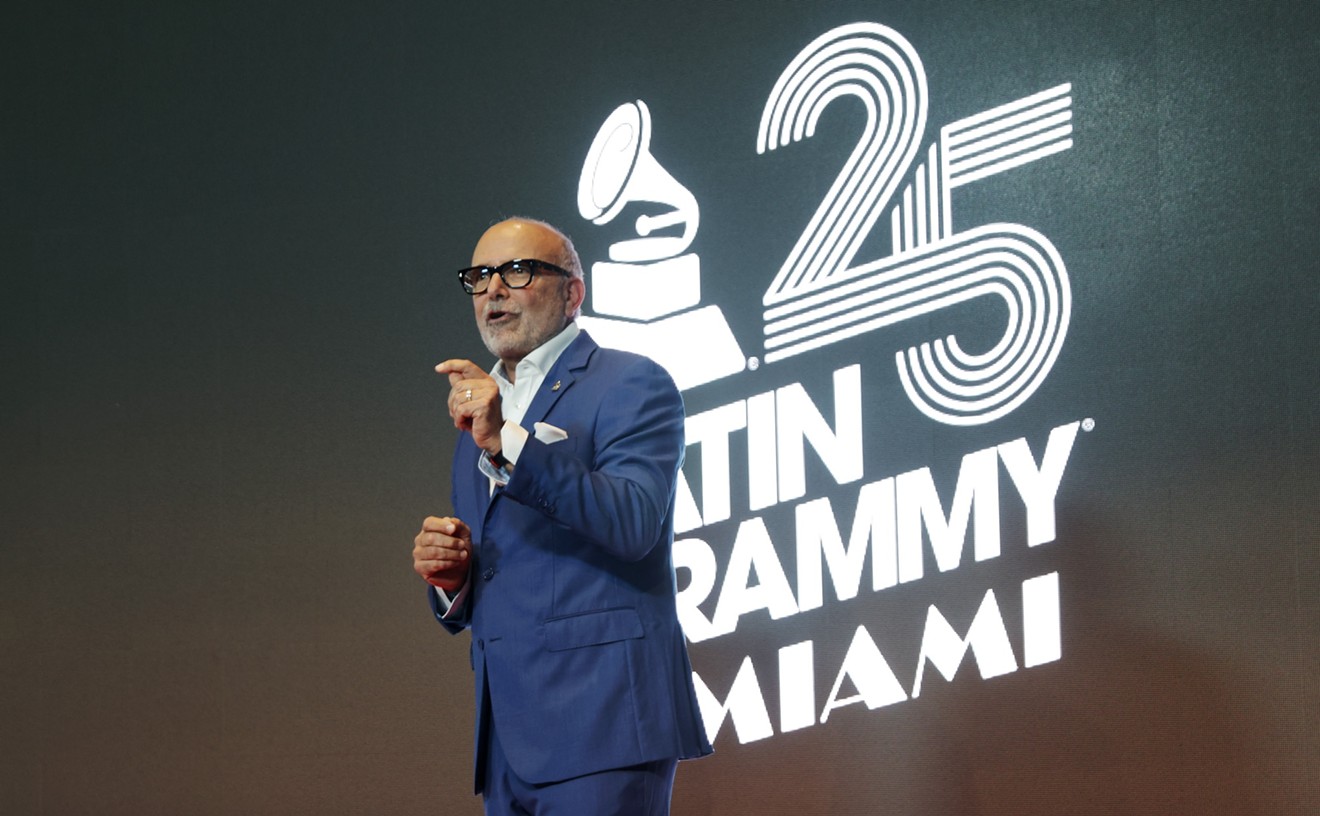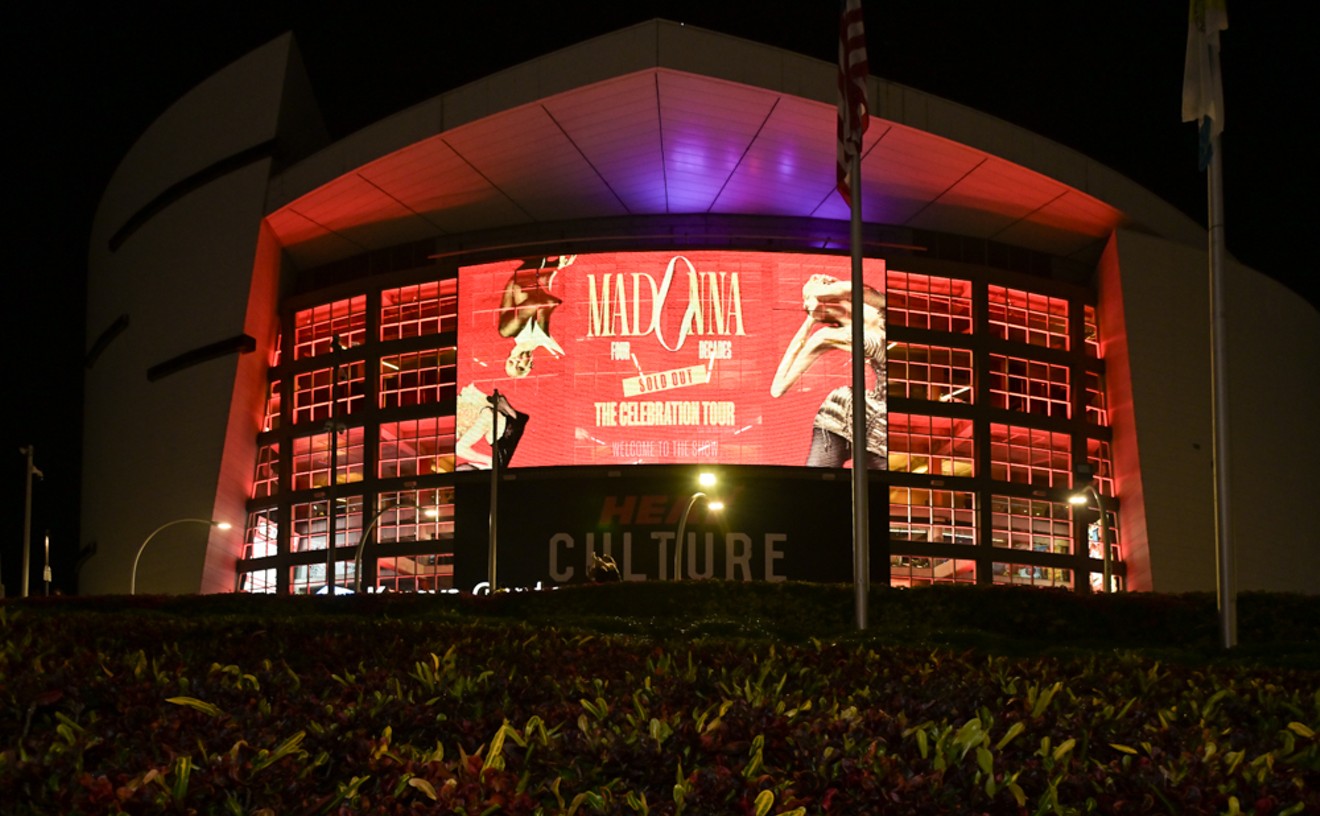It's a few hours till showtime at the Fillmore Miami Beach. Doors will open for Coheed and Cambria at 8 p.m., and around 4 p.m., the production team is inside readying the stage, running through a never-ending checklist of preshow preparations. Backstage, in the narrow hallway that cuts through the rear of the venue, a chubby yellow Lab named Bella, the unofficial Fillmore dog, trots past offices and dressing rooms. It's quiet and decidedly not chaotic. This is hardly the first show to happen at the Fillmore, after all.
Before it was the Fillmore, it was the Miami Beach Municipal Auditorium, then the Miami Beach Theater of the Performing Arts, then the Jackie Gleason Theater of the Performing Arts, and finally the Fillmore Miami Beach at the Jackie Gleason Theater. The Dick Clark Show and The Ed Sullivan Show have filmed episodes inside the venue, but your parents (and their parents) probably know the place best as the home of Jackie Gleason. He packed up production on his show in New York and began filming at the venue in 1964.
In Miami's unstable music market, the Fillmore — or whatever you want to call it — has been a fixture in South Beach since 1950. As local venues such as Tobacco Road and Grand Central succumb to construction and rising rent, the Fillmore watches from across the bay, undergoing iteration after iteration, somehow surviving a landscape that has bulldozed so many of its cohorts.
"We fight every day to get bands to come down."
tweet this
But when Live Nation took over the venue in 2007, all of the Fillmore's history wasn't as helpful as one might think. "The first three years were really tough for us," says
The Jackie Gleason Theater was for grandparents. The Fillmore wanted to be for kids. So how does one go from the Rat Pack to Odd Future?
Almost immediately, Live Nation did two seemingly small things to the Fillmore that had a huge impact. It installed a curtaining system, which basically cuts the room in half with, you guessed it, a curtain. It also made the venue general admission.
They were two big selling points to the indie bands Pessar was so desperately trying to court because, one, they no longer had to be intimidated by the size of the room (it goes from 2,713 to 1,154 when the curtain drops) and, two, general admission meant people could get up and dance.
The curtaining system allowed the Fillmore to find its place within Miami's music venues. "It was hard to get bands to come down,"
Live Nation also opened the Gleason Room, a smaller space toward the side of the venue that can host a crowd of about 200 to 400. It used to be just a rehearsal room. These days, it hosts a wide range of events, including comedy and charity functions, and also still serves its original purpose as a rehearsal hall.
And the whole general-admission thing is more important than it seems. A prime example: Miami's Olympia Theater. The historic and breathtakingly gorgeous downtown theater has undergone somewhat of an image transformation in the past two years. With stellar bookings like Neutral Milk Hotel, Kraftwerk, the Jesus and Mary Chain, and Sufjan Stevens, the Olympia Theater is slowly breaking away from its stuffy image as a fine arts venue, the kind of place attended by creaky white people in gowns and tuxedoes.
Almost.
Because, for all the wonderful shows it has hosted in the past year, the Olympia Theater is still having trouble in one key area: getting people out of their seats. New Times attended the Neutral Milk Hotel, Kraftwerk, and the Jesus and Mary Chain shows, and the only performance that got the crowd to stand up and dance was the last. And even then, the crowd was slightly unsure, occasionally reprimanded by a flashlight-wielding usher for dancing in the aisle.
So, slowly, the Fillmore persuaded acts to come a little farther south than Fort Lauderdale's Revolution Live. Pessar remembers a few early victories:
Today, especially with Grand Central out of the picture, it's no longer a shock when the Fillmore books big acts with
Bill Sisca took over the role as the Fillmore's general manager last summer. His priority for 2016 is the guest experience. He actually gave a PowerPoint presentation on it to his staff earlier in the day, and, to Sisca, it extends way beyond the Fillmore's property. "It starts with the way [the concertgoer] is made aware of when the ticket goes on sale. It continues on to the valet... our security, our staff." Essentially, it's much more than what happens during the performance. "After the show ends, [attendees] are still experiencing our venue. So what's the vibe like when they walk out?"
Pleasant, Sisca hopes. The Fillmore has recently been experimenting with live music in the lobby to help make the exodus more enjoyable.
But the artists who take the Fillmore's stage are guests of the venue too, and Sisca does his best to make sure they want to return. There's various rooms where the band and crew can chill out, play video games, or watch TV on a projector that takes up an entire wall. Need an extra piano? There's one downstairs. The Fillmore even has a dozen washers and dryers so bands don't need to send out for their laundry.
But despite all the amenities, it's never easy to get folks in the door, even with the national backing of live music powerhouse Live Nation. Pessar and Sisca have heard all the normal complaints about Miami's music scene: The crowds are fickle, talking through opening acts, showing up late, if at all. That's why local music venues are an endangered species in Miami, right?
"I'm sure that a lot of the places that are local — it's very hard," Pessar says. "We live in a spread-out market. It's not like we're in Manhattan. Here, most of the people who come to this venue are from Broward County — not even really Dade County. So it's spread out. That has a lot to do with it. You're not driving two minutes to check a band out. You've got to get your shit together right after work, go, and it's an adventure going out in South Florida."
But with its corporate access to national acts, the Fillmore also has a natural advantage over venues like Grand Central. National names sell tickets better than local bands. Still, the Fillmore isn't running on autopilot, Pessar says. "We fight every day to get bands to come down. We can't just sit back."
After putting in the groundwork, the Fillmore and Live Nation have successfully emerged from the shadow of Jackie Gleason. There's no sure thing in Miami, and as we see every year, nothing is sacred. But the Fillmore is focused on the future, not the past. "We want to grow and be bigger and get more shows in this room," Pessar says. "It's always what we want to do — to get more music here. That's always the goal. We could always do more, right?"











